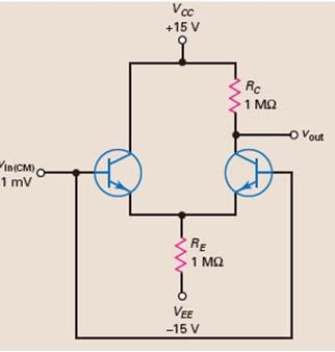A) preamp.
B) tuned RF amp.
C) common-collector.
D) differential amp.
Correct Answer

verified
Correct Answer
verified
Multiple Choice
The most popular integrated circuits and the ICs manufactured with all components being part of one chip are called ________.
A) trivalent
B) pentavalent
C) duolithic
D) monolithic
Correct Answer

verified
Correct Answer
verified
True/False
With diff amp configurations,the voltage gain is maximum when a single-ended output is used.
Correct Answer

verified
Correct Answer
verified
Multiple Choice
The Intel P4 Prescott version microprocessor contains approximately
A) 125 transistors.
B) 125 thousand transistors.
C) 125 million transistors.
D) 125 billion transistors.
Correct Answer

verified
Correct Answer
verified
Multiple Choice
The diff amp is extremely useful as the input stage of an op amp because
A) it has low input impedance.
B) it has a single-ended input.
C) it amplifies the common-mode signal.
D) it attenuates the common-mode signal.
Correct Answer

verified
Correct Answer
verified
Multiple Choice
Which of the following is not a characteristic of an op amp?
A) unity voltage gain
B) very high input impedance
C) very high voltage gain
D) very low output impedance
Correct Answer

verified
Correct Answer
verified
Multiple Choice
In an op amp,the difference of the dc currents is called the
A) input offset current.
B) input bias current.
C) difference current.
D) dc mean current.
Correct Answer

verified
Correct Answer
verified
True/False
Base resistors can produce input error voltages when the two halves of the diff amp are not perfectly symmetrical.
Correct Answer

verified
Correct Answer
verified
Multiple Choice
In the manufacturing process of an IC,the procedure of sealing off the epitaxial layer with silicon dioxide is called ________,
A) compensation
B) sealation
C) passivation
D) crystallization
Correct Answer

verified
Correct Answer
verified
Multiple Choice
The formula used to convert the CMRR to decibels is
A) 10 log CMRR.
B) 20 log CMRR.
C) 30 log CMRR.
D) 40 log CMRR.
Correct Answer

verified
Correct Answer
verified
Multiple Choice
What is the output voltage for the circuit shown in Figure 15-21? 
A) 15 mV
B) 1.5 mV
C) 0.5 mV
D) 0.5 V
Correct Answer

verified
Correct Answer
verified
True/False
The typical op amp is a dc amplifier with very high gain,very high input impedance,and very low output impedance.
Correct Answer

verified
Correct Answer
verified
Multiple Choice
The voltage gain of a differential amplifier divided by its common-mode voltage gain is referred to as the
A) input offset voltage.
B) common-mode rejection ratio.
C) differential output.
D) active load ratio.
Correct Answer

verified
Correct Answer
verified
Multiple Choice
What is the type of IC that is manufactured with resistors and capacitors integrated,but transistors and diodes are connected as discrete components?
A) thin film or thick film
B) analog
C) digital
D) hybrid
Correct Answer

verified
Correct Answer
verified
Multiple Choice
When a differential amplifier is not perfectly symmetrical
A) there will be a small ac output voltage.
B) there will be no common-mode amplification.
C) there will be no ac output voltage.
D) there will be 0 V at the output.
Correct Answer

verified
Correct Answer
verified
Multiple Choice
An amplifier that performs a mathematical operation is referred to as
A) a math amp.
B) an op amp.
C) a calc amp.
D) a comp amp.
Correct Answer

verified
Correct Answer
verified
True/False
The input bias current of an op amp is defined as the sum of the dc base currents.
Correct Answer

verified
Correct Answer
verified
True/False
A diff amp is sometimes called a long-tail pair because the two transistors share a common collector resistor.
Correct Answer

verified
Correct Answer
verified
True/False
A differential amplifier output requires that the load is single-ended and has one end grounded.
Correct Answer

verified
Correct Answer
verified
Multiple Choice
What can produce input error voltages when the two halves of the diff amp are not perfectly symmetrical?
A) collector resistors
B) emitter resistors
C) base resistors
D) coupling capacitors
Correct Answer

verified
Correct Answer
verified
Showing 21 - 40 of 50
Related Exams